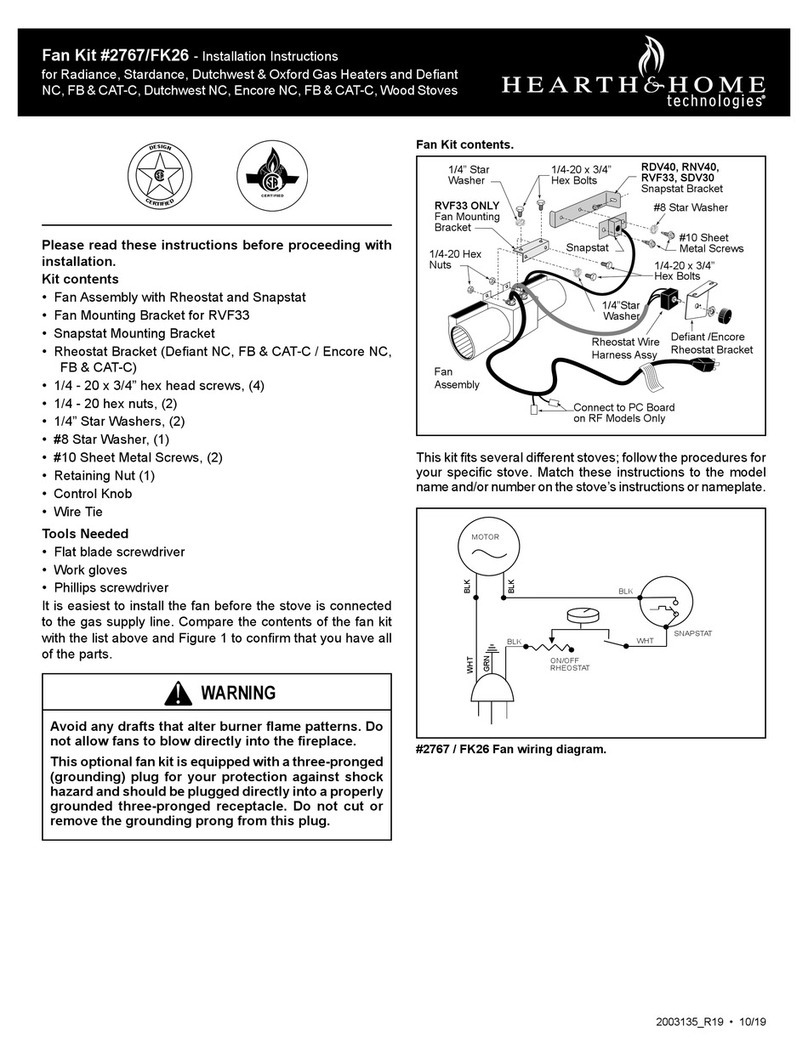Hearth & Home Technologies • DVP Venting System • 4033-215 Rev E • 11/20/17
6
G. Install the Heat Shield and Horizontal Ter-
mination Cap
Heat Shield Requirements for Horizontal Termination
For all horizontally terminated appliances, a heat shield
MUST be placed 1 in. above the top of the vent between
the wall shield restop and the base of the termination cap.
There are two sections of the heat shield. One section is
factory-attached to the wall shield restop. The other sec-
tion is factory-attached to the cap.
WARNING! Risk of Fire! TO PREVENT overheating and
re, heat shields must extend through the entire wall
thickness. Heat shields must overlap 1-1/2 in. (38 mm)
minimum.
If the wall thickness does not allow the required 1-1/2 in.
(38 mm) heat shield overlap when installed, an extended
heat shield must be used.
If the wall thickness is less than 4-3/8 in./111 mm, the heat
shields on the cap and wall shield restop will need to be
trimmed. A minimum 1-1/2 overlap MUST be maintained.
NOTICE: Heat shields may notbeeldconstructed.
The extended heat shield may need to be cut to length.
You will attach the cut heat shield to the existing cap heat
shield or wall shield restop heat shield using the supplied
screws.
You MUST maintain a 1-1/2 in. (38 mm) overlap of the
extended heat shield and the existing shields (both ends of
the heat shield). The small leg on the extended heat shield
should rest on the top of the vent (pipe section) to properly
space it from the pipe section.
Note: For horizontal vent runs through a combustible wall
and framing dimensions, refer to appliance installation
manual.
WARNING! Risk of Fire! Thetelescopinguesectionof
the termination cap MUST be used when connecting vent.
• 1-1/2 (38 mm) minimum overlap of vent and telescoping
uesectionisrequired.
Failuretomaintainoverlapmaycauseoverheatingandre.
Install the Horizontal Termination Cap
Attach slip section of cap to last vent section. Maintain
1-1/2 in. overlap between slip and vent sections.
Secure termination cap to exterior wall using provided
holes and fasteners.
Vent termination must not be recessed in the wall. Siding
may be brought to the edge of the cap base.
Flash and seal as appropriate for siding material at outside
edges of cap.
When installing a horizontal termination cap, follow
the cap location guidelines as prescribed by current
ANSI Z223.1 and CAN/CGA-B149 installation codes.
Note: When using termination caps with a factory-supplied
heat shield attached, no additional wall shield restop is
required on the exterior side of a combustible wall.
CAUTION! Risk of Burns! Local codes may require
installation of a cap shield to prevent anything or anyone
from touching the hot cap.
Note: Where required, an exterior wall ashing is available.
When penetrating a brick wall, a brick extension kit is available
for framing the brick.
H.DivertRoofRun-o
HHT recommends, where excessive water run-o is
possible, use of one of the three options shown below
to prevent water running o the roof and onto/into the
horizontal termination cap:
Install gutter
Install L-shaped
diverter
Install TRAP-VSS
(available from
your HHT dealer)
Figure16DivertRoofRun-o



























